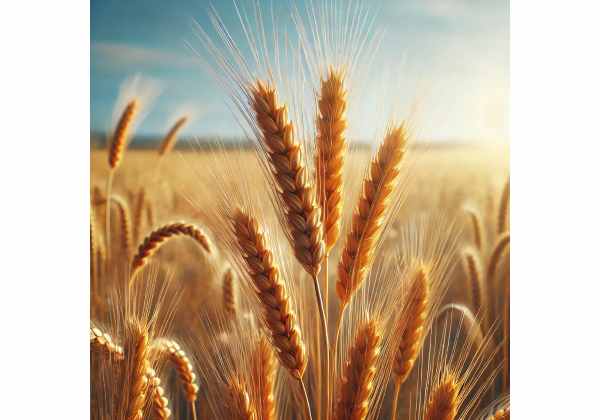Kamut is an ancient grain renowned for its unique nutty flavor, exceptional nutritional profile, and rich history. Valued for its high protein content, abundant minerals, and bioactive compounds, Kamut has emerged as a sought-after superfood in modern diets. Often celebrated for its potential to support cardiovascular health, boost immunity, and aid in digestion, this remarkable grain bridges traditional wisdom with contemporary nutritional science. In this comprehensive analysis, we delve into Kamut’s agronomic profile, chemical constituents, health advantages, practical applications, and significant research findings—providing an engaging guide for culinary enthusiasts, health-conscious individuals, and researchers alike.
Table of Contents
- Agronomic Profile and Species Identification
- Phytochemical Analysis and Bioactive Ingredients
- Nutritional Perks and Vital Characteristics
- Practical Uses and Safety Protocols
- Recent Studies and Research Discoveries
- Frequently Asked Questions
Agronomic Profile and Species Identification
Kamut, often referred to as Khorasan wheat, is an ancient grain that has been cultivated for millennia in the fertile regions of the Middle East. Botanically classified within the Triticeae tribe, Kamut is a subspecies of wheat that exhibits unique morphological and genetic traits distinguishing it from modern wheat varieties. Its elongated grains, deep golden hue, and robust kernel structure are telltale signs of its ancient lineage. This grain thrives best in well-drained soils with moderate fertility and flourishes under organic farming practices, which emphasize minimal chemical inputs and sustainable cultivation.
Historically, Kamut’s origins can be traced back to the banks of the Nile and the ancient lands of Mesopotamia, where it was revered not only as a staple food but also as a symbol of prosperity. Today, Kamut is grown in select regions around the world, including parts of North America, Europe, and Australia, where conditions mimic its native climate. The grain’s resilience to variable weather conditions and its adaptability to diverse soil types have contributed to its steady resurgence in the modern organic food movement.
Morphologically, Kamut plants are characterized by their tall, slender stalks that support large, plump seed heads. The leaves are broad with a vibrant green tint, and the overall plant exhibits a robust growth pattern that is both aesthetically pleasing and agriculturally advantageous. Farmers appreciate its natural resistance to certain pests and diseases, which often reduces the need for synthetic pesticides. The deep-rooted system of Kamut aids in soil stabilization and moisture retention, making it a valuable crop in regions prone to drought.
The grain’s unique characteristics extend to its culinary properties as well. Kamut’s large, chewy kernels yield a rich, buttery flavor when cooked, making it a popular choice for salads, pilafs, and hearty breads. Its golden color and distinct taste not only elevate the visual appeal of dishes but also contribute to a satisfying texture that modern consumers are beginning to favor over refined grains. The preservation of its ancient genetic traits is seen as a significant advantage, offering a glimpse into agricultural practices of the past while meeting contemporary dietary demands.
Scientific research has focused on the genetic makeup of Kamut, revealing that its ancient lineage may contribute to higher levels of proteins, lipids, and essential micronutrients compared to modern wheat. Detailed genomic studies indicate that the resilience and nutritional density of Kamut stem from centuries of natural selection in harsh, arid environments. The grain’s robust genetic profile not only provides superior nutritional benefits but also positions it as a sustainable option in the face of climate change.
Modern agronomists are particularly interested in Kamut’s ability to grow organically without compromising yield or quality. This attribute has spurred innovative cultivation methods, such as crop rotation and intercropping, to maintain soil health and promote biodiversity. Many organic farmers have adopted Kamut into their crop rotations, citing its minimal environmental impact and the grain’s contribution to long-term soil fertility. Additionally, its ability to sequester carbon and enhance soil microbial activity positions Kamut as an eco-friendly alternative to conventionally grown wheat.
In summary, the agronomic profile and species identification of Kamut highlight a blend of historical significance, robust adaptability, and exceptional nutritional value. Its distinct morphological features, coupled with a sustainable growth pattern, have cemented Kamut’s reputation as both a culinary delight and an agricultural marvel. As research continues to uncover the genetic and environmental factors that contribute to its unique properties, Kamut stands as a testament to the enduring legacy of ancient grains in the modern world.
Phytochemical Analysis and Bioactive Ingredients
Kamut’s nutritional prowess is deeply rooted in its complex phytochemical composition. Extensive research has uncovered a myriad of bioactive ingredients that not only contribute to its rich flavor but also offer numerous health benefits. Below is an exploration of the key compounds that define Kamut’s therapeutic and nutritional profile:
- Alkylresorcinols
Alkylresorcinols are phenolic lipids predominantly found in the outer layers of whole grains, including Kamut. These compounds exhibit strong antioxidant properties that help neutralize free radicals, thereby reducing oxidative stress. Studies have suggested that higher levels of alkylresorcinols in ancient grains may be linked to reduced risks of chronic diseases such as cardiovascular disorders and certain cancers. - Polyphenols and Flavonoids
Kamut is a rich source of polyphenolic compounds, including a variety of flavonoids. These natural antioxidants play a crucial role in protecting the body against inflammation and cellular damage. By scavenging harmful free radicals, polyphenols in Kamut help maintain cellular integrity, support heart health, and may even contribute to anti-aging effects. Their presence also enhances the grain’s overall flavor profile by imparting subtle, complex tastes. - Selenium
An essential trace mineral, selenium is known for its role in bolstering the body’s antioxidant defense system. In Kamut, selenium is present in bioavailable forms that aid in detoxification processes and support thyroid function. Adequate selenium intake has been linked to improved immune response and reduced inflammation, underscoring its importance as a vital micronutrient in this ancient grain. - B-Vitamins Complex
Kamut offers an impressive range of B-vitamins, including thiamine (B1), riboflavin (B2), niacin (B3), and folate (B9). These vitamins are integral to energy metabolism, nervous system function, and the maintenance of healthy skin and mucous membranes. The B-vitamin complex in Kamut supports efficient energy production and contributes to overall metabolic health, making it a beneficial addition to daily nutrition. - Carotenoids
Although more commonly associated with fruits and vegetables, carotenoids are also present in Kamut. These pigments, including lutein and zeaxanthin, serve as potent antioxidants and are critical for maintaining eye health. The presence of carotenoids in Kamut not only enhances its nutritional profile but also adds to its visual appeal, contributing to the grain’s characteristic golden hue. - Dietary Fiber
While not a chemical compound in the traditional sense, the high dietary fiber content in Kamut is a key contributor to its health benefits. Fiber plays an essential role in maintaining digestive health, regulating blood sugar levels, and promoting a feeling of fullness. Kamut’s fiber-rich profile supports gastrointestinal function and aids in the prevention of metabolic disorders. - Essential Fatty Acids
Found primarily in the germ of the grain, essential fatty acids such as omega-3 and omega-6 play a pivotal role in cardiovascular health and inflammation regulation. Though present in modest amounts, these fatty acids contribute to the overall nutrient density of Kamut, supporting cell membrane integrity and promoting healthy cholesterol levels.
The synergistic interaction of these bioactive compounds in Kamut creates a nutritional matrix that is greater than the sum of its parts. Modern analytical techniques, such as high-performance liquid chromatography (HPLC) and mass spectrometry, have enabled researchers to precisely quantify these constituents, thereby validating traditional claims about the grain’s health benefits. The interplay between antioxidants, vitamins, and minerals in Kamut not only enhances its nutritional quality but also positions it as a functional food with potential therapeutic applications.
Furthermore, the inherent balance of these compounds in Kamut is influenced by factors such as soil quality, climate, and cultivation practices. Organic farming methods have been shown to enhance the concentration of these bioactive ingredients, which in turn improves the grain’s overall efficacy as a health-promoting food. Researchers continue to explore ways to optimize cultivation and processing techniques to preserve and even amplify these beneficial compounds in Kamut-based products.
In essence, the phytochemical analysis of Kamut reveals a treasure trove of bioactive ingredients that contribute to its robust health benefits. From potent antioxidants like alkylresorcinols and polyphenols to essential micronutrients such as selenium and B-vitamins, every component plays a strategic role in enhancing human health. As scientific interest in ancient grains grows, Kamut’s unique chemical profile is being recognized as a key factor in its rising popularity among nutritionists, chefs, and health enthusiasts worldwide.
Nutritional Perks and Vital Characteristics
Kamut’s appeal extends far beyond its exquisite taste and historical significance—it is a powerhouse of nutrition that offers a wide range of health benefits. This ancient grain is celebrated for its robust nutritional profile, which includes a balance of proteins, carbohydrates, healthy fats, and an array of essential vitamins and minerals. Here, we explore the various nutritional perks and vital characteristics that make Kamut an outstanding addition to a modern, health-conscious diet.
One of the standout features of Kamut is its high protein content. Compared to modern wheat varieties, Kamut typically contains a greater proportion of protein, which is essential for muscle repair, enzyme production, and overall cellular health. This protein quality, combined with a well-balanced amino acid profile, makes Kamut particularly attractive for individuals seeking to boost their dietary protein intake naturally.
In addition to protein, Kamut is rich in complex carbohydrates that provide a steady release of energy throughout the day. Unlike refined grains that can cause rapid spikes in blood sugar, Kamut’s fiber-rich carbohydrates help stabilize glucose levels, thereby reducing the risk of energy crashes and supporting metabolic health. The grain’s low glycemic index is a significant advantage for those managing diabetes or aiming to maintain consistent energy levels.
Another notable benefit of Kamut is its high concentration of dietary fiber. Fiber plays a crucial role in promoting healthy digestion by regulating bowel movements and supporting the growth of beneficial gut bacteria. A diet rich in fiber is associated with a lower risk of gastrointestinal disorders, improved cholesterol levels, and a reduced likelihood of developing metabolic syndrome. Kamut’s natural fiber content also aids in weight management by fostering a sense of fullness, which can help control overall calorie intake.
Kamut is also an excellent source of essential micronutrients. The grain’s abundant supply of B-vitamins, including thiamine, riboflavin, niacin, and folate, is vital for energy metabolism, brain function, and the maintenance of healthy skin. These vitamins work synergistically to convert food into energy, ensuring that the body operates efficiently. Moreover, the presence of minerals such as magnesium, zinc, and iron supports various physiological functions, from muscle contraction and immune response to oxygen transport in the blood.
Beyond its macronutrient and micronutrient composition, Kamut boasts a rich profile of antioxidants. These natural compounds help protect the body from oxidative stress, which is implicated in the aging process and the development of chronic diseases. The antioxidants in Kamut, including polyphenols and carotenoids, contribute to its anti-inflammatory properties and may help mitigate the risk of heart disease and certain cancers.
For those with an active lifestyle, Kamut offers additional benefits. Its slow-digesting carbohydrates provide sustained energy, making it an ideal choice for athletes and individuals engaged in regular physical activity. The combination of protein, fiber, and healthy fats also supports muscle recovery and overall stamina. This unique nutritional synergy makes Kamut a favored ingredient in sports nutrition products and energy bars.
Furthermore, Kamut is often lauded for its potential to improve overall digestive health. The grain’s natural composition is less likely to trigger adverse reactions compared to some modern wheat varieties. Many consumers report better digestion and reduced bloating when incorporating Kamut into their diets, a benefit that is increasingly valued in the realm of functional foods.
Overall, the nutritional perks and vital characteristics of Kamut make it an exceptional grain for supporting long-term health. Its comprehensive nutrient profile—encompassing high-quality proteins, complex carbohydrates, essential vitamins and minerals, and potent antioxidants—positions Kamut as a functional food with far-reaching benefits. Whether consumed as part of a hearty salad, used in artisanal bread, or integrated into a balanced meal plan, Kamut provides an array of health advantages that can enhance overall well-being and promote a vibrant, active lifestyle.
Practical Uses and Safety Protocols
Kamut’s versatility is evident in its wide range of applications, from culinary creations to nutritional supplements. As an ancient grain with a rich flavor profile and impressive nutritional credentials, Kamut has found its way into numerous recipes and health products. In this section, we explore the practical uses of Kamut and provide safety protocols to ensure that its consumption remains both enjoyable and beneficial.
Culinary Applications
Kamut is a favorite among chefs and home cooks alike due to its distinctive nutty taste and chewy texture. It can be used as a substitute for modern wheat in various recipes, including breads, pasta, salads, soups, and pilafs. When cooked, Kamut’s kernels retain a firm texture, making them ideal for hearty dishes that require a satisfying bite. Many culinary experts appreciate its ability to absorb flavors, allowing it to be paired with a variety of herbs, spices, and other ingredients.
To prepare Kamut, it is recommended to rinse the grains thoroughly and soak them for several hours or overnight. This soaking process not only reduces cooking time but also enhances digestibility by breaking down anti-nutrients such as phytic acid. Once soaked, Kamut can be boiled or steamed until tender, after which it can be incorporated into salads, grain bowls, or served as a side dish.
Nutritional Supplements and Functional Foods
Beyond its use as a whole grain, Kamut is increasingly incorporated into nutritional supplements and functional food products. Its concentrated nutrient profile makes it an excellent candidate for inclusion in energy bars, breakfast cereals, and health shakes. Manufacturers are harnessing the natural benefits of Kamut to create products that cater to health-conscious consumers seeking whole-food sources of energy and nutrition.
Cosmetic and Industrial Uses
While primarily consumed for its nutritional benefits, Kamut extracts have also begun to appear in the cosmetic industry. The antioxidants and vitamins found in Kamut are believed to support skin health and may be used in formulations for creams, lotions, and facial masks. Although research is still emerging in this area, early studies suggest that Kamut’s bioactive compounds could contribute to anti-aging and skin-repair benefits.
Safety and Precautionary Measures
Despite its numerous benefits, it is important to observe safety protocols when incorporating Kamut into your diet. Although Kamut is generally well tolerated, individuals with wheat allergies or gluten sensitivities should exercise caution. While some proponents claim that Kamut is easier to digest than modern wheat varieties, it still contains gluten and may not be suitable for those with celiac disease or severe gluten intolerance.
Usage Guidelines and Recommendations:
- Start Slowly: Introduce Kamut gradually into your diet to allow your body to adjust to its high fiber and protein content.
- Soaking and Cooking: Always soak the grains to improve digestibility and reduce anti-nutrient levels.
- Portion Control: Consume moderate servings to avoid gastrointestinal discomfort, particularly if you are not accustomed to a high-fiber diet.
- Consult a Specialist: Individuals with specific dietary restrictions or health conditions should consult a healthcare professional before making significant dietary changes.
Practical Home Tips
For those eager to experiment with Kamut at home, here are a few practical tips:
- Kamut Salad: Combine cooked Kamut with fresh vegetables, a drizzle of olive oil, lemon juice, and your favorite herbs for a refreshing, nutrient-dense salad.
- Kamut Bread: Use Kamut flour as a partial or full substitute in bread recipes to create a hearty, flavorful loaf that offers a unique twist on conventional wheat bread.
- Breakfast Bowl: Mix cooked Kamut with yogurt, fruits, and a sprinkle of nuts for a satisfying and energizing breakfast.
By following these practical guidelines and safety protocols, consumers can fully appreciate the diverse applications of Kamut while minimizing potential risks. Whether you are an avid home cook, a nutrition enthusiast, or a professional chef, Kamut offers a versatile ingredient that enriches both taste and health. Its adaptability across culinary and industrial applications ensures that this ancient grain continues to captivate and nourish modern lifestyles.
Recent Studies and Research Discoveries
Scientific interest in Kamut has surged in recent years, with researchers seeking to understand the grain’s unique composition and its implications for human health. A growing body of literature highlights Kamut’s potential as a functional food with diverse therapeutic benefits. Below is an overview of several notable studies that have contributed to our understanding of Kamut’s bioactive properties and health applications:
- Study on Antioxidant Capacity (2017)
Published in the Journal of Agricultural and Food Chemistry, this study compared the antioxidant properties of Kamut with those of modern wheat varieties. Researchers found that Kamut exhibited significantly higher levels of alkylresorcinols and polyphenols, which contributed to its robust antioxidant capacity. The study concluded that the elevated antioxidant profile of Kamut may help protect against oxidative stress-related diseases, including cardiovascular disorders and certain cancers. - Comparative Nutritional Analysis (2018)
A research project featured in Food Research International analyzed the nutritional differences between Kamut and contemporary wheat. The study revealed that Kamut contains higher concentrations of essential amino acids, B-vitamins, and minerals such as selenium and zinc. These findings support the hypothesis that Kamut’s ancient genetic makeup endows it with a superior nutrient profile, which can contribute to improved energy metabolism and overall health. - Digestibility and Glycemic Response Study (2019)
In a clinical trial published in Nutrition Research, scientists investigated the glycemic impact of Kamut consumption compared to modern wheat products. Participants who consumed Kamut-based meals exhibited a slower and more sustained increase in blood glucose levels, suggesting that Kamut may be beneficial for managing insulin sensitivity and reducing the risk of type 2 diabetes. The study’s results advocate for the inclusion of Kamut as part of a balanced, low-glycemic diet. - Inflammatory Markers and Immune Response (2020)
A study conducted in collaboration with several European research institutions, published in Nutrients, examined the effects of Kamut consumption on inflammatory markers and immune function. The researchers observed a notable reduction in pro-inflammatory cytokines among subjects who incorporated Kamut into their diets over a period of several weeks. These findings indicate that Kamut’s bioactive compounds, particularly its polyphenols and selenium content, may exert beneficial anti-inflammatory effects and support overall immune health. - Potential Cardiovascular Benefits (2021)
An exploratory study featured in The American Journal of Clinical Nutrition assessed the impact of Kamut on cardiovascular health. The research highlighted that regular consumption of Kamut was associated with improved lipid profiles, reduced blood pressure, and enhanced endothelial function. These cardiovascular benefits were attributed to Kamut’s high levels of antioxidants and essential nutrients, which collectively contribute to maintaining vascular integrity and reducing arterial inflammation. - Impact on Gut Microbiota (2022)
Emerging research, published in Gut Microbes, has begun to explore the influence of ancient grains on the human gut microbiome. Preliminary findings suggest that the high fiber content and unique phytochemical composition of Kamut may promote a diverse and beneficial gut bacterial community. A healthy gut microbiota is linked to improved digestion, enhanced immune function, and overall metabolic health, further underscoring the multifaceted benefits of incorporating Kamut into one’s diet.
Together, these studies provide compelling evidence that Kamut is not only nutritionally dense but also possesses unique bioactive properties that support long-term health. The ongoing research continues to unravel the mechanisms through which Kamut exerts its effects, paving the way for its broader application in functional foods and nutraceuticals. As more data emerge, Kamut’s role as a staple in health-focused diets is likely to expand, affirming its status as a valuable resource in both traditional and modern nutrition.
Frequently Asked Questions
What distinguishes Kamut from modern wheat varieties?
Kamut, an ancient grain, has a unique nutritional profile characterized by higher protein content, elevated levels of antioxidants, and a richer array of essential minerals. Its traditional cultivation and minimal genetic modification set it apart from contemporary wheat varieties.
How can Kamut be incorporated into daily meals?
Kamut is versatile in the kitchen—it can be used in salads, soups, bread, pasta, and pilafs. Soaking the grains before cooking enhances digestibility, and it can be substituted for modern wheat in many recipes for a nutty, robust flavor.
Are there any safety concerns associated with Kamut consumption?
While Kamut is nutritious for most individuals, it contains gluten and may not be suitable for those with celiac disease or severe gluten intolerance. Gradually introducing Kamut into your diet and consulting a healthcare professional can help mitigate any adverse effects.
What health benefits does Kamut offer?
Kamut provides a wealth of health benefits, including improved digestion, sustained energy release, enhanced immune function, and cardiovascular support, primarily due to its high protein, fiber, and antioxidant content.
Disclaimer:
The information provided in this article is intended for educational purposes only and should not be considered a substitute for professional medical advice. Always consult a qualified healthcare professional before making any changes to your health regimen.
If you found this article informative and engaging, please consider sharing it on Facebook, X (formerly Twitter), or your favorite social platform. Follow us on social media for more updates and insights into ancient grains and holistic nutrition!

















